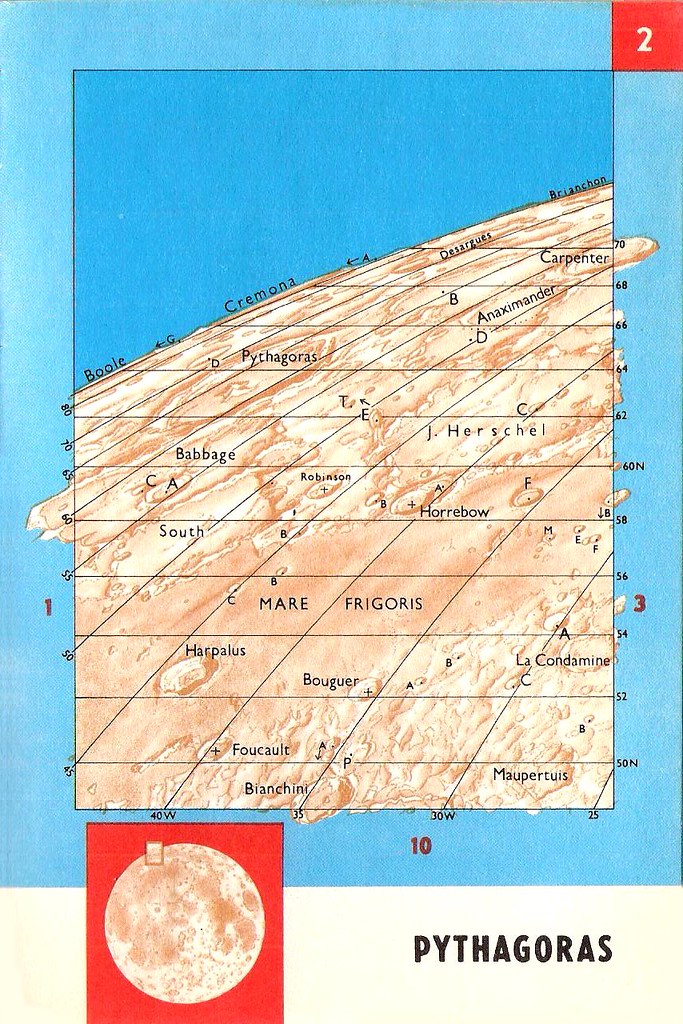|
02.Pythagoras The northern-western part of the visible side of the Moon, Mare Frigoris and Sinus Roris join here. At the right of the chart the crater Pythagoras distinguishes itself from its surroundings by its high terraced wall and it central mountain.. ANAXIMANDER - Anaximander. (Ἀναξίμανδρος) (ca. 611 - 574 BC) Greek Philosopher from the town of Milete. Pupil of Thales, introduce the gnomon in Greece, created a map of the world.
BABBACHE - Charles Babbage. (1792 - 1871) English mathematician, inventor and engineer. Worked on logarithm tables. Early designer of a mechanical programmable computer.
BIANCHINI - Francesco Bianchini. (1662 - 1729) Italian astronomer philosopher and scientist, observed Venus and worked on the improvement of the calendar.
BOOLE - George Boole (1815 - 1864) English mathematician, inventor of Boolean logic, which forms the basis of the modern digital computer.
BOUGUER - Pierre Bouguer. (1698 - 1758) French hydrographic specialist, surveyor and astronomer.
CARPENTER - 1. James Carpenter. (1840 - 1899) Astronomer, and co-author of a Book about the Moon. 2. Edwin Francis Carpenter. (1898 - 1963) American astronomer, researched white dwarf stars, supernovae and did galactic astronomy.
LA CONDAMINE - Charles-Marie de la Condamine. (1701 - 1774) French explorer, geographer, and mathematician.
CREMONA - Luigi Cremona. (1830 - 1903) Italian mathematician.
DESARGUES - Gérard Desargues. (1591-1661) French mathematician and engineer, one of the founders of projective geometry.
FOUCAULT - Léon Foucault. (1814 – 1897) French physicist, measured the of the speed of light.
HARPALUS - Harpalus (Ἅρπαλος ). (ca. 460 BC) Greek thieve.
HERSCHELL J. - Sir John Frederick William Herschel. (1792 - 1871) English mathematician, astronomer, chemist, and experimental photographer/inventor, son of William Herschel. Named seven moons of Saturn and four moons of Uranus. He made many contributions to the science of photography.
HORREBOW - Peder Horrebow. (1679 - 11764) Danish mathematician and physicist, astronomer. Director of the Observatory of the University of Copenhagen. Inventor of the Horrebow-Talcott Method, to determine a place's latitude through observing the stars near the Zenith.
|

MAUPERTUIS - Pierre Louis Moreau de Maupertuis. (1698 - 1759) French mathematician, philosopher and man of letters. Director of the Académie des Sciences, and the first President of the Prussian Academy of Science. Maupertuis went on an expedition to Lapland to determine the shape of the Earth.
PYTHAGORAS - Pythagoras. (Πυθαγόρας ὁ Σάμιος) (ca. 570 BC - ca. 495 BC) Greek mathematician and philosopher.
ROBINSON - John T. R. Robinson. (1792 - 1882) Irish astronomer and Physicist.
SOUTH - James South. (1785 - 1867) English astronomer. South and John Herschel jointly produced a catalogue of 380 double stars in 1824, re-observing many of the double stars that had been discovered by William Herschel. South then continued and observed another 458 double stars over the following year.
|